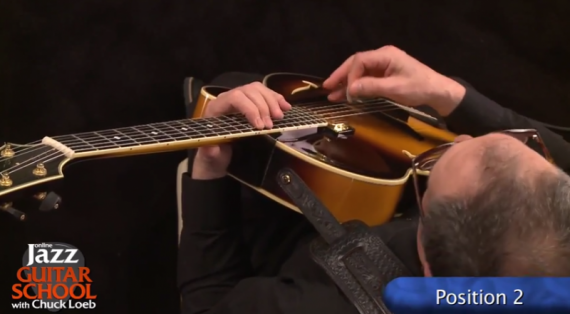The Online Jazz Guitar School with Chuck Loeb
by Veritas on Apr.02, 2014, under News, Videos
One of the most important things in Jazz Guitar is being able to improvise. To pull off a good solo, you need to know which key and scales work with the backing chords. What can be confusing when learning jazz guitar is that there are a variety of patterns and locations to play the same scale. It’s important to know the most efficient way of finding the right notes for the desired key from anywhere on the neck as you move around.
The way to do this is to learn the geography of the fretboard and understand how the notes relate to each other – which brings us to what Chuck Loeb refers to throughout his jazz guitar lessons as “The 6 Positions.”
To put it simply, “The 6 Positions” are a way to simplify the neck of the guitar into 6 different hand patterns (shapes) for playing the same scale. So why would you need to know the Major Scale in 6 Positions? Basically it’s about playing the same scale in different areas of the guitar – you want to know how to find any note on the neck, in any key. Chuck’s method boils a vast and complicated subject down to 6 Positions. These 6 Positions serve as a guide to help you memorize all the notes in a certain area, which will help you find the right note in any key, anywhere on the neck.
Within each of the 6 Positions, there are different major scales that you can access. The online jazz guitar curriculum in the new Online Jazz Guitar School with Chuck Loeb contains individual lessons that break down each of the 6 Shapes into much greater detail, but this sample lesson focuses on why these 6 Shapes are so important to establish a foundation for playing jazz guitar. So for this lesson Chuck demonstrates how to play each of the 6 Positions in one key (F Major), all across the neck.
Position 1 starts on the 1st fret with the first finger on the 6th string (low E string). As Chuck demonstrates, it covers all the notes of the guitar from the 1st fret to the 5th fret.

Position 2 starts on the 13th fret on the 6th string with an F note using the second finger, and covers all notes of the guitar from the 12th fret to the 15th fret.

Position 3 also starts on the F note on the 13th fret, but this time using your pinky.

Position 4 starts on the 8th fret and is similar to the 1st position, but this time starts on the 5th string.

Position 5 is similar to the 2nd Position, but this time it starts on the 5th string and ends on the 6th fret.

Position 6 uses the pinky and ends on the 5th fret taking you right back to where the 1st position meets again.

The idea is that wherever you find yourself on the neck, you can find the notes for the key you’re in and have them available to play in an efficient way. It’s important to note that members of Chuck’s new online jazz guitar school also have the ability to submit practice videos to Chuck for his feedback and playing advice. They also have access to diagrams, backing tracks, chord charts and transcriptions of each lesson.
For more information about jazz guitar lessons with Chuck Loeb visit ChuckLoebGuitar.com and be sure to fill out the form for more free samples from his online guitar school.





